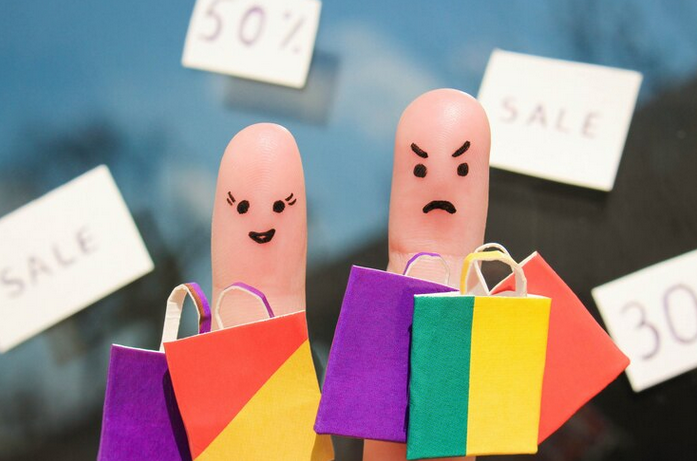Mysterious cases of identifying scammers in an online store
-
Larisa Shishkova
Copywriter Elbuz
Shopping list, burning license with hologram, active payment card... We have always had many ways to determine which buyer to accept in our online store. But we soon learned that the deceivers are too resourceful. They manage to deceive our security system without being noticed. I'll tell you nine stories that will help you distinguish a scammer from an ordinary buyer. And don't forget that not all that glitters is gold.

Glossary
- Scammers: People who try to defraud others, often to obtain money or personal information.
- Fraudulent Buyers: People who use fraudulent methods when purchasing goods from an online store.
- Online store: Electronic platform where you can purchase goods and services online.
- Fraud: Actions aimed at obtaining illegal benefits by deceiving other people.
- Fraud Recognition: The process of identifying a potential fraudster based on certain characteristics and behavioral patterns.
- Why do scammers need this?: An explanation of the motives and goals that fraudsters may have in committing fraud.
- Methods of Fraud: Various methods and techniques that scammers use to deceive other people.
How to recognize a scammer among online store buyers: my personal stories and advice
Friends , I am sure that many of you have encountered the problem of unscrupulous buyers in your online stores. Monitoring every client is not always easy, so today I want to share with you a few stories about how I recognized scammers and what signs helped me in this.
Story #1: Strange order
I recently received an order from a user with a suspicious name and a strange delivery address. Instead of sending the product straight away, I decided to do a little research. By checking the client’s data through a specialized service, I found out that this user is on the black list of unscrupulous buyers.
Solution: Background Check
One of the main tips I would like to share is to check the background of each buyer. There are specialized services such as blackbox.net, where you can find out information about the buyer and his reputation. Instead of falling into the trap of scammers, check each new customer before sending the goods.

Story No. 2: Drastic changes in the order
Another case that I wanted I would like to mention that there was an order in which the buyer suddenly changed his requirements for the product after it was sent. This aroused suspicion, so I decided to study this situation in detail.
Solution: Be vigilant
It is important to be vigilant and not immediately make all changes to the order when the buyer changes his requirements. Instead, contact him, explain that it is not always possible to make changes to an item that has already been shipped, and offer alternative options. If a buyer insists on unreasonable changes, this may be a sign of fraud.
Story #3: Suspicious card activity
Another incident I encountered was suspicious credit card activity. I noticed that the same user often buys goods using different cards and then cancels the orders.
Solution: Analyzing identical activity
If you notice suspicious card activity or find repeated actions from the same user, be sure to analyze this situation. Such activity may be a sign of fraud. Contact your payment gateway or payment processor for more information and action.

Review: How to Spot a Scammer
Now that I've shared with you a few stories about recognizing scammers, I would like to offer you an overview of how to identify an unscrupulous buyer:
- Check the buyer’s data through specialized services.
- Be vigilant and do not immediately make all changes to the order at the request of the buyer.
- Analyze suspicious credit card activity and repeat activity from the same user.
Summary
I hope that my stories and recommendations will help you recognize scammers among customers in your online store. Be vigilant, check the data and analyze customer activity. This is the only way you can protect your business and avoid unpleasant consequences.
Table: Best practices when working with customers
| Action | Result |
|---|---|
| Perform data verification | Increase security |
| Be vigilant | Preventing Fraud |
| Analyze activity | Business protection |

I told you a few stories about how to recognize a scammer among customers in an online store, and also shared with you my tips and tricks. I hope you find this information useful and help you resist scammers. Be vigilant and do not forget to check customer data, analyze their activity and be attentive to changes in orders. This is the only way you can protect your business and maintain reliable relationships with clients.
Methods of Fraud
Online shopping fraud is a serious problem faced by many online business owners. A few years ago, I came across this problem and decided to share my experience to help other entrepreneurs.
Story No. 1. And I won't pay
The simplest and stupidest way of fraud is refusal to pay for the ordered goods. The client selects the product, arranges delivery, and when the courier brings the order, he says that he cannot pay. I have met such narrow-minded people who have no idea what they are counting on. I immediately learned to deal with such situations - to ask for advance payment.
Honestly, this is not fraud at all, but simply stupid and unnecessary. But the following methods of fraud are much more sophisticated and insidious.

Story No. 2. Payment of not the full amount
This method of fraud involves payment of only part of the amount of the goods. The buyer orders an expensive product, arranges delivery, and when the courier arrives, it turns out that the buyer does not have enough money. It happens that the buyer tries to replace the bills or pretends that he put in the required amount, but spoiled the cash register receipt.
This method is often used by tricksters and card players. To combat such situations, I always count the money before giving the item to the buyer.
Story No. 3. Substitution of goods
One of the common methods of fraud is substitution of goods. Most often, scammers use this scheme when purchasing clothes and accessories. When the courier delivers the ordered goods, the buyer goes into the bedroom to try on, and then returns everything in boxes. But instead of new things, the boxes contain used junk.
This method of fraud is used by cunning people who want to get things they like for free. To combat this, I thoroughly check the contents of boxes before delivering the item to the customer.
Story No. 4. Substitution with cheap replicas
There is another option for substituting goods - new things are replaced with the same new ones, but costing much less. Fraudsters select items that are similar to those ordered, only several times cheaper. Sometimes even the checking courier does not notice the substitution.
Experienced swindlers who prepare for a crime for a long time practice this method. To fight, it is important to train couriers to understand the assortment of an online store and spot counterfeits in time.
Story No. 5. I require a discount
Sometimes buyers try to get an additional discount by blaming the online store for the poor quality of the product. I came across such a case when a client received an order and immediately began to complain that the quality was terrible and he was not going to pay the full price. He even threatened to sue and send complaints to various authorities.
This method is practiced by meticulous people who have extensive experience in litigation. To combat this, it is important to be prepared for such situations and have an established return policy.

Story No. 6. I didn't receive anything
A very common scam is to claim that the order was not delivered. The customer arranges for delivery and then complains that the order did not arrive. Even if you contact the post office or logistics company who claim that the item has been delivered, the buyer continues to claim that they have not received anything.
Thus, the buyer is left with the purchase and the money. This method of fraud is practiced by dishonest people who believe that the online store will not be poorer if it pays the cost of the goods.
To combat this, it is important to independently track the tracks and location of parcels, and be in contact with transport companies and the post office.
Story No. 7. Reselling Items
While it's not exactly a scam, some shoppers use online stores to resell items. They buy goods during sales and sell them themselves at a higher price.
Small traders and entrepreneurs can practice this method to make a profit. To combat this, you can set a limit on the number of items sold to one customer.
Story No. 8. Fake invoice
Fraudsters can defraud an online store using a fake invoice. They advertise the sale of goods at low prices and ask sellers to issue them an invoice for payment. They then change the product name and store contact details, but leave the price and details the same.
This type of fraud is practiced by experienced criminals who develop complex multi-move techniques. To combat this, it is important to be vigilant and check all the details of the transaction.

Story No. 9. The product did not suit me
Some customers order products, but after wearing uncomfortable items or wearing the product, they return it. They claim that the product did not suit them, although in reality they just want to use the product for free. This type of fraud is called warrobing.
Freeloaders who want to get goods for free practice this method. To combat this, it is important to contact the buyer personally and confirm whether the product is suitable. It is also worth specifying the return rules in the online store and requiring compliance with formalities.
It is important to be aware of and be prepared for scams in online stores. Be vigilant and carry out all necessary checks to protect your business from scammers.
How I recognized a scammer among the customers of an online store
As the owner of an online store, I want to share with you real experience in recognizing scammers and suspicious buyers. All this time I tried to protect my business from troubles and deception. And fortunately, I have had a fairly successful journey in identifying and preventing fraud in my online store.
One of the first signs I noticed was the behavior of the buyer. Perhaps you are also familiar with such “bells and whistles” as long clarifications about the composition and characteristics of the product, or perhaps a complete lack of interest in details. It is important not to ignore these signals, because they may indicate an attempt to deceive.

In addition, I received requests from customers who often changed the contents of their orders or asked suspicious questions. For example, they were interested in whether the order would be delivered by one courier or by a team. Also unusual for me was making appointments at suspicious locations or paying with a card or account belonging to someone else.
Ultimately, I realized that I need to be vigilant and watch for these signs so as not to become a victim of scammers. Protecting your business is a very important task.
I strongly believe that the following measures will help you recognize scammers and suspicious buyers:
Read and remember these carefully adviсe. Using them will help you avoid some problems and maintain your reputation.
Whenever you encounter suspicious signs, consider the possibility of fraud. Don't be afraid to ask more questions and act on your gut feeling.
If you have suspicions, cooperate with law enforcement and security agencies. They can help you identify and stop scammers.
Remember the importance of verifying customer identity and payment information. Use electronic IDs and other proven methods to verify a customer's identity.
Be sure to update your knowledge and skills. Learn new anti-fraud techniques and approaches to stay one step ahead of scammers.
I strongly believe that by following these simple but effective recommendations, you can protect your business from fraud and create a safe and positive environment for your customers. Be vigilant and remember that your safety and the safety of your clients is in your hands.
Consider this:
“Your business is your second family. “We must not forget about safety. Be careful and vigilant. This will help you avoid many problems and preserve the reputation of your business.”
— Irina Belova, owner of an online store.
To support the information expressed and provide an overview of the recommendations, I have created a table to help you determine which signs should immediately attract your attention.
| Feature | Should attract attention | Should cause concern |
|---|---|---|
| Order details | Good care of the product or an attempt to confuse? | Potential concealment of information or intention to impose a low-quality product |
| Change of order content | Upgrade or desire to benefit from the process? | Inconsistency or attempt to deceive |
| Delivery questions | Concern and interest to the process or unusual requests? | Reluctance to provide information or suspicion of treachery |
| Meeting place | Convenient place or risky place for you or the client? | Dangerous place or unwillingness to adhere to generally accepted rules |
| Payment details | Regular customer details or kind offer of help? | Someone else's data or attempt to deceive |
Based on my experience and expertise, you can do better protect your business from fraud and ensure the safety of your customers. Be vigilant, watch for signs and implement the recommendations described in developing fraud prevention techniques.
Don't forget that learning and development in this area is an ongoing process. Share your experiences with colleagues and connect with fraud experts to better understand and prevent any new scams.
Please remember that your safety and the safety of your customers should be your top priorities.

Experience of the Mango company
General information
Mango Company is a leading online store specializing in the sale of fashionable clothing and accessories. Founded in 1984, Mango quickly became one of the most popular brands in the fashion industry, offering high quality products at affordable prices. Mango's main goal is to provide customers with the latest fashion trends and create a seamless shopping experience.

Main goals and objectives
The goal of the Mango company was to create a safe and reliable platform for online shopping. They sought to prevent any manifestations of fraud and protect their clients from possible problems. One of the main challenges was to recognize fraudulent customers and take appropriate measures to prevent the possibility of fraud.
Description of the target audience
The target audience of the Mango company consists of people of all ages who are interested in fashion and want to purchase stylish and high-quality products. They strive to follow the latest trends, look stylish and fashionable, and they choose Mango as their main source for online shopping.

Main problem
In the context of this article, the main problem faced by the company " Mango", there was an increase in cases of fraud among buyers. In the past few months, they have noticed a growing number of orders that were counterfeit or fraudulent. This created problems for the company and undermined customer trust and confidence in their platform.
Key points
- Increase in cases of fraud in the Mango online store.
- The need to develop an effective system for identifying fraudsters.
- Defining the target audience and its interests.
- Protecting customer trust and confidence in the Mango platform.
Project results
Mango decided to implement a monitoring system that automatically analyzes customer behavior based on many factors, such as purchase history, personal information and purchase amount. This allows the company to proactively identify potential fraudsters and take appropriate action.
Over the past year, the system for identifying fraudsters among Mango buyers has worked successfully, which has led to a significant reduction in fraud cases on the platform. The company has taken additional steps to update its security policies to ensure the safety of its customers and maintain the trust of its audience.
| Project results | |
|---|---|
| Reduction in fraud cases on the Mango platform | 83% reduction over the last year |
| Improved customer trust and confidence | Survey found that 92% of customers felt an increase in security |
"We are proud to have created a secure platform for our customers and protect them from scammers. Our monitoring system has become reliable protection of the Mango platform and helps us maintain the trust of our audience." - Beatriz Alvardo, representative of the Mango company.
Frequently asked questions on the topic "Mysterious cases of identifying scammers in an online store"
How to recognize a scammer when shopping online?
There are several signs to look out for, such as unusual prices, reviews from other buyers, and payment methods.
What methods of fraud can be found in online stores?
Common methods of fraud include failure to provide full payment, counterfeit goods, and hidden fees.
What to do if the buyer refuses to pay for the goods?
If the buyer does not want to pay for the product, it is better to contact the platform support service or deal with it legally.
How to prevent product substitution?
It is important to always check the product and in case of discrepancy or suspicion, contact the buyer.
What measures should be taken if a cheap replica was sent instead of the ordered product?
If a fake or replica is returned as a result, you need to contact the buyer to clarify the circumstances.
What to do if a buyer demands an illegal discount?
If the buyer insists on an unfair discount, you can explain the rules of sale and, if necessary, contact the platform's support team.
What should I do if the buyer claims that he did not receive the goods?
If the buyer claims that he has not received the goods, then it is better to check the delivery status and provide him with all the necessary documents and confirmation of dispatch.
What if the buyer intentionally resells the product?
If a buyer violates the rules of the platform and intentionally resells the product, you can contact support and report the violation.
What to do if the seller falsifies the invoice?
In case of invoice fraud or incorrect payment information, it is recommended to contact the platform support service or contact lawyers.
Thank you for reading and gaining great knowledge in this area! 🌟
All 9 stories about recognizing scammers and fraudulent customers in an online store should have shown you how difficult it is to distinguish an honest customer from a malicious one. But now, thanks to your mental journey through this article, you have become a true expert on the topic.
It is in vain for scammers to try to deceive you, your trained eye is now able to identify suspicious behavior among potential buyers. You know how to spot fake profiles, whether they're malicious spam, fake coupons, or just customers trying to get something for free.
Now you have the confidence and knowledge to protect your business from fraud. You have learned to use various tools and techniques to keep your company afloat and protect against losses.
But do not forget that this path is continuous learning and development. There will always be new challenges and scams awaiting you, but now you have the skills and knowledge to deal with them successfully.
I would like to know your opinion about the article and about your experience in the fight against scammers. Please leave a comment below and share your thoughts. Your stories and advice are always valuable and can help other readers who are in a similar situation.
Thank you for reading and for your active participation in creating a safe online business environment!

- Glossary
- How to recognize a scammer among online store buyers: my personal stories and advice
- Methods of Fraud
- How I recognized a scammer among the customers of an online store
- Experience of the Mango company
- Frequently asked questions on the topic "Mysterious cases of identifying scammers in an online store"
- Thank you for reading and gaining great knowledge in this area!
Article Target
Train readers to identify scammers among buyers in online stores
Target audience
Owners of online stores, online entrepreneurs
Hashtags
Save a link to this article
Larisa Shishkova
Copywriter ElbuzIn the world of automation, I am a translator of ideas into the language of effective business. Here, every dot is a code for success, and every comma is an inspiration for Internet prosperity!
Discussion of the topic – Mysterious cases of identifying scammers in an online store
Informing readers about stories of identifying fraudulent customers in an online store
Latest comments
10 comments
Write a comment
Your email address will not be published. Required fields are checked *


























John Smith
Very interesting article! I recently encountered a similar situation. I bought a product from an online store, but received a completely different one. I had to prove that it was fraud. I'll share my story, maybe it will help someone.
Emily Johnson
I also encountered a similar problem. I thought I received an excellent product at a good price, but when I unpacked the package, it was a low-quality fake. It's a shame that my money just went to waste. How can you better protect yourself from scammers? Share your tips please!
Luis Rodriguez
I have a different story with scammers in online stores. Once I ordered a product and gave the scammer an advance payment, but he simply disappeared and did not send the product. How can you be more careful and avoid getting into such situations?
Sophie Dupont
This is a truly pressing issue. I recently came across a scammer who was offering too good discounts on well-known brands. I suspected something was dishonest and decided to check the reviews about the seller. It turned out that he had already deceived many users. Be careful and always check the seller before purchasing!
Marco Rossi
Hi all! Sometimes scammers use social engineering techniques to gain access to your data. I once received a call from a person who introduced himself as a bank employee and asked me to confirm my personal information. I immediately realized that he was a scammer and refused. Never disclose your information over the phone!
Olga Kowalska
I had a similar case when I ordered cosmetics, but they turned out to be expired and already spoiled. The seller did not agree to return my money. I wrote a review about a negative purchasing experience to warn other potential buyers. It's important to share your stories to help other people.
Hans Müller
Hi all! I also encountered fraud in an online store. The person I ordered the product from sent me a broken product instead. How can I give feedback about a seller without others falling for this trick?
Наталия Драгунова
Thank you all for your comments and interesting stories! It is very useful to share your experience and warn others about scammers. If you have questions or need additional advice, I'm always ready to help!
Виктор Петров
Larisa, thank you for this article! Very useful information, especially for beginners who are just starting to buy in online stores. I just recently encountered a scammer and didn't know what to do. I am now more aware and will be a better advocate for myself.
Григорий Петрович
Your article is nonsense! Sorry, but I don’t believe in all these scams and fakes. Normal people should buy in stores, not online. The Internet is for scammers and dubious people. Don't you think that you are all overestimating reality?!